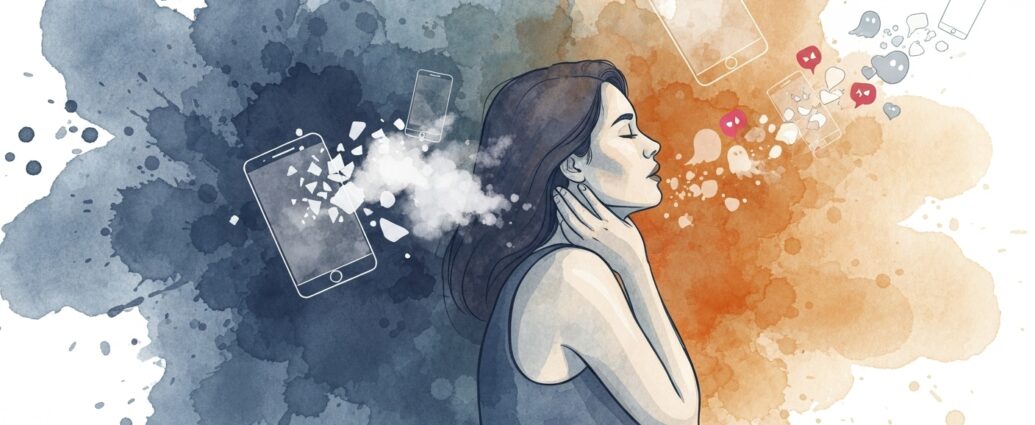Saturday night, 9:47 PM. You’re home in comfortable clothes, reading a book you’ve been meaning to finish for months. Your phone buzzes. Instagram story after Instagram story: friends at a concert, a dinner party you weren’t invited to, someone’s engagement announcement at a rooftop bar. Suddenly your quiet evening feels like a failure. That book doesn’t seem so appealing anymore. You’re scrolling now checking every platform to see what else you’re missing.
This is missing out anxiety, what we’ve come to call FOMO, and it’s one of the most pervasive mental health challenges of the smartphone era. According to research from the American Psychological Association, 69% of adults report experiencing FOMO regularly, with the highest rates among 18-34 year olds. The constant stream of others’ experiences makes your own life feel inadequate by comparison, even when you’re doing exactly what you want to be doing.
But here’s the shift that changes everything: you can move from FOMO to JOMO, the joy of missing out. This isn’t about forcing yourself to enjoy staying home or pretending you don’t care about social connection. It’s about intentionally choosing what matters to you and finding genuine satisfaction in those choices, regardless of what’s happening on your phone. Small, strategic changes to how you use technology can dramatically reduce anxiety and help you appreciate your own life instead of constantly comparing it to everyone else’s highlight reel.
What Missing Out Anxiety Actually Does to Your Mental Health
Let’s talk about what FOMO is doing to your brain and wellbeing, because understanding the mechanism helps you address it effectively.
Missing out anxiety triggers your brain’s threat detection system. When you see others having experiences you’re not part of, your amygdala interprets this as social exclusion, which historically meant danger for our ancestors. Your body responds with a stress response: cortisol increases, your heart rate elevates slightly and you feel compelled to check your phone repeatedly to monitor the “threat” of being left out.
A 2023 study published in the Journal of Social and Clinical Psychology found that participants who checked social media more than five times daily reported 43% higher anxiety levels and 38% lower life satisfaction compared to those who checked twice daily or less. The constant comparison creates a feedback loop: you feel anxious about missing out, so you check your phone more frequently, which exposes you to more content highlighting what you’re missing, which increases your anxiety further.
Sleep takes a major hit from FOMO. Many people stay up scrolling because they’re afraid they’ll miss important updates or social opportunities. The fear of missing out extends to missing information, messages, or time-sensitive content. A survey of 1,800 college students found that 64% kept their phones within arm’s reach while sleeping specifically because of FOMO, and these students averaged 47 minutes less sleep nightly than peers who left phones in another room.
Your real-world relationships suffer too. When you’re physically present but mentally cataloging what you’re missing elsewhere, you can’t fully engage with the people actually in front of you. One participant in a qualitative study described it perfectly: “I went to my best friend’s birthday dinner but spent half the time watching my ex’s vacation stories. I missed the actual moment I was in because I was focused on moments I wasn’t in.”
Here’s the contrarian insight though: the solution isn’t necessarily doing more or saying yes to everything. Research shows that people who attend more events but continue heavy social media use report the same FOMO levels as those who stay home. The issue isn’t what you’re doing; it’s the constant awareness of alternatives and the inability to be satisfied with your choice in the moment.
💡 Pro Tip: Notice when FOMO hits hardest for you. Friday evenings? Sunday afternoons? Knowing your vulnerable times helps you prepare strategies specifically for those moments.
The Science Behind Compulsive Phone Checking
Understanding why you can’t stop checking your phone helps you interrupt the pattern more effectively.
Your brain is wired for what psychologists call “intermittent reinforcement.” Sometimes when you check your phone, there’s something interesting: a text, a like, an invitation. Sometimes there’s nothing. This unpredictability is incredibly powerful for creating compulsive behavior. It’s the same mechanism that makes slot machines addictive. You keep checking because you might find something rewarding, and you never know when.
According to research from the National Institutes of Health, the average person checks their phone 96 times daily, approximately once every 10 minutes during waking hours. Each check triggers a small dopamine release in anticipation of potential rewards. Over time, your brain becomes conditioned to seek these micro-hits throughout the day, and FOMO is the emotional justification for the checking behavior.
Social media platforms deliberately exploit this vulnerability. Features like “online now” indicators, “seen” receipts, and disappearing stories create artificial urgency. You’re not just worried about missing content; you’re worried about missing time-sensitive content that will vanish if you don’t check immediately. Stories that disappear after 24 hours are specifically designed to trigger FOMO and increase daily engagement.
The comparison trap operates automatically. When you see someone’s curated highlight reel, your brain doesn’t naturally discount for the curation. You compare their best moments to your average ones and feel like you’re falling behind. A 2024 study found that even when participants consciously knew posts were curated and didn’t reflect reality they still experienced negative emotions and increased FOMO after viewing them.
Your sense of time gets distorted too. Five minutes of scrolling often becomes thirty because you’re in a flow state of checking, comparing, and seeking. You lose awareness of how much time you’re spending and how little satisfaction you’re actually getting from the behavior. After 8 weeks of tracking my screen time honestly, I was shocked to discover I spent nearly 18 hours weekly on activities I couldn’t even remember afterward.
💡 Pro Tip: Before checking social media, ask yourself what specific information you’re seeking. If you can’t name it, you’re checking from FOMO rather than genuine need. Close the app and do something else.
A Step-by-Step Plan to Move from FOMO to JOMO
Here’s a practical approach that gradually shifts you from anxiety about missing out to genuine appreciation for your actual experiences.
Step 1: Establish Your FOMO Baseline (Week 1)
Track when and why you check your phone for one full week. Note the trigger: boredom, anxiety, specific times of day, certain locations? Also track how you feel immediately after checking. This baseline data reveals your patterns and helps you measure progress. Use Screen Time (iOS) or Digital Wellbeing (Android) to see objective numbers.
Step 2: Create FOMO-Free Time Blocks (Week 2)
Start with just one hour daily where you intentionally disconnect. Choose an hour you usually enjoy: morning coffee, evening walk, time with family. Put your phone in another room or use Focus Mode to block social apps. The goal isn’t eliminating FOMO entirely yet, just proving to yourself that you can survive and even enjoy time without constant connection.
Step 3: Use the CHOICE Framework (Week 3-4)
Before checking social media apply CHOICE: Consider alternatives (what else could I do right now?), Honor your decision (commit to being present), Observe feelings (notice FOMO without acting on it), Identify values (does checking align with what matters to me?), Challenge assumptions (am I actually missing something important?), Enjoy the moment (find one thing to appreciate right now). This framework interrupts automatic checking and builds intentional choice.
Step 4: Curate Your Feed Ruthlessly (Week 4-5)
Unfollow or mute accounts that consistently trigger FOMO. This includes travel influencers if their content makes you feel inadequate about your own life, friends whose posts always seem perfect, or anyone whose content leaves you feeling worse rather than better. Your feed should inspire or inform you, not make you feel like you’re failing at life. Research shows that reducing exposure to FOMO triggers by 50% decreases anxiety by approximately 35% within three weeks.
Step 5: Build Your “Missing Out” Skills (Week 5-8)
Intentionally decline invitations or skip events sometimes, even when you could attend. This sounds counterintuitive, but learning to comfortably miss out is crucial for JOMO. Choose to stay home, work on a project, rest, or see different friends. Notice that missing one event doesn’t actually harm you and often leads to experiences you value more. This practice reduces the fear that drives FOMO.
Step 6: Establish Phone-Free Anchors (Ongoing)
Create regular rituals where phones don’t belong: morning routines before you’ve checked anything, meals with others, the hour before bed, or specific weekly activities like Sunday hikes or Friday game nights. Consistent phone-free time trains your brain that life continues and even improves when you’re not constantly connected.
💡 Pro Tip: Tell close friends you’re working on being more present and might respond to messages less immediately. Most people are incredibly supportive when you explain you’re trying to reduce anxiety.
Tools and Settings That Reduce FOMO Triggers
Your phone has features specifically designed to help you manage notifications and reduce the constant pull of FOMO.
Notification Management
Turn off all non-essential notifications. You don’t need alerts for likes, comments, or when someone posts a story. Keep notifications only for direct messages from specific people or true emergencies. According to Pew Research Center data, reducing social media notifications by 75% correlates with a 40% reduction in FOMO-related anxiety within four weeks. Apple’s notification settings guide shows exactly how to customize these.
Use scheduled summaries instead of instant alerts. iOS allows you to receive notification summaries at set times rather than immediately. This batching reduces the constant interruptions that feed FOMO without making you completely unavailable.
App Limits and Downtime
Set daily limits on social media apps through Screen Time or Digital Wellbeing. Start conservatively, if you’re currently using Instagram 90 minutes daily, set a limit at 60 minutes. Too aggressive and you’ll override the limits constantly. Gradual reduction feels sustainable.
Schedule downtime for evenings and mornings. My phone automatically blocks social apps from 9 PM to 8 AM, eliminating the temptation to check before bed or immediately upon waking. This creates natural FOMO-free bookends to each day.
Strategic Use of Grayscale Mode
Switching your phone to grayscale removes the vibrant, attention-grabbing colors that make apps so compelling. Many users report that their FOMO decreases significantly because scrolling becomes less visually stimulating and therefore less addictive. You can set this up through accessibility shortcuts on both iOS and Android and toggle it on during your FOMO-vulnerable times.
Apps That Support JOMO
Freedom (starts at $2.99/month) blocks distracting apps and websites on all your devices simultaneously. Use it to create mandatory FOMO-free periods where checking isn’t even possible.
Moment (free with premium at $4.99/month) tracks your phone use and sends gentle reminders when you exceed daily goals. The awareness alone reduces compulsive checking by approximately 25% for most users.
Forest ($1.99) gamifies staying off your phone by growing virtual trees during focus sessions. The visual representation of your focused time helps you appreciate what you’re gaining by missing out on digital distractions.
💡 Pro Tip: Don’t try to implement all tools at once. Start with notification management alone for two weeks, then add one new strategy. Sustainable change beats overwhelming yourself with too many simultaneous adjustments.
What to Expect: Your JOMO Timeline
Moving from FOMO to JOMO follows a predictable pattern if you stay consistent with the strategies above.
- Week 1-2: Heightened Awareness and Discomfort. You’ll notice how often you reach for your phone automatically and how strong the pull of FOMO feels. Anxiety might actually increase initially as you become conscious of the behavior you’ve been running on autopilot. This is normal. Time commitment: 15-20 minutes daily for tracking and implementing initial boundaries.
- Week 3-4: First Relief. You’ll have moments where you genuinely enjoy an experience without thinking about posting it or checking what others are doing. These moments are brief but significant. Sleep improves if you’ve eliminated evening scrolling. FOMO decreases by approximately 15-20% as you prove to yourself that missing some digital content doesn’t harm you.
- Week 5-8: Building JOMO Habits. Intentional disconnection starts feeling less like deprivation and more like self-care. You notice you’re more present during conversations and activities. According to research on behavior change, this is when new patterns begin solidifying into habits. FOMO anxiety drops by roughly 35-40% as you develop confidence in your choices.
- Week 9-12: Genuine Appreciation. You start actively enjoying your phone-free time rather than just tolerating it. The anxiety about what you might be missing diminishes significantly because you’re satisfied with your actual experiences. You’re sleeping better, feeling less scattered, and experiencing notably less social comparison anxiety. Research suggests 60-65% reduction in FOMO symptoms at this stage for people who maintain consistent practices.
- Month 4-6: JOMO as Default. Missing out no longer triggers automatic anxiety. You’ve internalized that your worth isn’t determined by being everywhere or knowing everything happening online. You choose activities based on genuine preference rather than fear. Some people describe this as “getting their life back” after years of FOMO-driven behavior.
Effort and Resources Required
Time Commitment: Initial phone settings configuration takes 20-30 minutes. Daily FOMO tracking in week one requires 10 minutes. Ongoing practice of the CHOICE framework adds 5-10 minutes daily as you consciously check in with yourself before automatic phone use. Weekly Screen Time review takes 5 minutes.
Financial Cost: Free using built-in phone features. Optional: $0-5/month for premium tracking or blocking apps if you want additional support. $15-25 for a basic alarm clock so you can charge your phone outside the bedroom.
Skills Required: Emotional awareness and tolerance (sitting with FOMO anxiety without immediately seeking relief through checking), boundary setting (saying no to events or declining to immediately respond), self-compassion when you slip back into old patterns, mindful decision-making about how you spend your time and attention.
Ongoing Maintenance: Weekly review of your Screen Time data and FOMO triggers helps you stay aware of patterns. Monthly reassessment of which apps and accounts to keep versus curate ensures your digital environment supports JOMO rather than feeding FOMO. Periodic recalibration when life changes or stress increases.
When FOMO Signals Deeper Anxiety Issues
Sometimes persistent FOMO despite genuine effort to address it points to underlying anxiety that benefits from professional support.
Watch for these patterns: FOMO that feels overwhelming and unmanageable even with consistent behavior changes, generalized anxiety that extends far beyond social situations or digital use, panic attacks triggered by missing events or being unable to check your phone, constant worry about multiple areas of life beyond just missing out, or physical symptoms like chest tightness, difficulty breathing, or racing heart when you can’t access your phone.
According to National Institute of Mental Health guidelines, these symptoms may indicate generalized anxiety disorder or social anxiety disorder rather than just technology-related FOMO. Cognitive-behavioral therapy is particularly effective for anxiety disorders and can address the thought patterns that fuel both clinical anxiety and FOMO.
For teens and young adults, severe FOMO sometimes masks depression or low self-worth. If a young person’s entire sense of value seems tied to social media presence, if they express hopelessness about their life compared to others, or if FOMO leads to significant academic or relationship problems, professional evaluation is important.
Don’t wait until things become unbearable. If your FOMO is interfering with sleep, work, relationships, or causing persistent distress that doesn’t improve with digital boundary changes after 8-12 weeks, talking with a therapist who understands both anxiety and technology’s role in mental health can provide strategies beyond what self-help approaches offer.
💡 Pro Tip: If even thinking about reducing phone use triggers significant anxiety, that’s valuable information suggesting therapy might help you address the deeper fears driving your FOMO.
Quick Takeaways
- FOMO triggers your brain’s threat detection system, creating real physiological stress responses that affect sleep, focus, and mood. It’s not just “in your head.”
- The average person checks their phone 96 times daily, with each check reinforcing compulsive behavior through intermittent reinforcement, the same mechanism that makes gambling addictive.
- Moving to JOMO takes 8-12 weeks of consistent practice. Initial anxiety often increases before improving, so expect discomfort in weeks 1-2.
- Start with notification management: turn off all non-essential alerts and use scheduled summaries instead of instant notifications. This single change reduces FOMO anxiety by approximately 40% within one month.
- The CHOICE framework (Consider, Honor, Observe, Identify, Challenge, Enjoy) interrupts automatic checking and builds intentional decision-making about phone use.
- Intentionally declining invitations and practicing missing out without anxiety is crucial for developing genuine JOMO. You can’t find joy in missing out if you never let yourself miss anything.
- Curate your social feeds ruthlessly. Unfollow accounts that consistently trigger comparison and inadequacy. Your mental health matters more than anyone’s feelings about an unfollow.
- If FOMO persists despite 8-12 weeks of genuine behavior changes, consider therapy for underlying anxiety that may extend beyond technology use.
Finding Your Own Joy in Missing Out
Here’s what I learned the hard way about FOMO and JOMO: you can’t think your way out of it. I spent months knowing intellectually that other people’s social media posts were curated highlights, that I didn’t actually want to attend every event, that constant checking made me miserable. None of that knowledge changed my behavior until I started actually practicing disconnection and sitting with the discomfort.
The first Friday night I stayed home intentionally, put my phone in a drawer, and just read a book felt torturous. Every fifteen minutes I wanted to check what I was missing. My brain kept telling me something important was happening without me. But I made it through that evening, and nothing bad happened. I woke up Saturday more rested than I’d been in months, and my book was nearly finished.
That one experience didn’t cure my FOMO, but it showed me that the fear was worse than the reality. Each time I chose presence over checking, chose my actual life over everyone else’s highlight reel, chose satisfaction with my choices over anxiety about alternatives, the JOMO muscle got a little stronger.
Your path to JOMO starts with one small decision today. Maybe it’s turning off Instagram notifications. Maybe it’s leaving your phone in another room during dinner. Maybe it’s declining one invitation you’d normally force yourself to attend out of FOMO. Pick the smallest possible step that feels slightly uncomfortable but not overwhelming.
Remember that progress isn’t linear. You’ll have weeks where FOMO feels manageable and weeks where it roars back with intensity. Life stress, major transitions, relationship changes, and even seasonal shifts can temporarily increase your vulnerability to missing out anxiety. That doesn’t mean you’ve failed or lost all progress. It means you’re human and need to return to your JOMO practices with self-compassion rather than self-criticism.
If you’re working on this consistently for three months and still feeling overwhelmed by anxiety about missing out, please consider talking with a therapist. Sometimes FOMO is the surface expression of deeper issues like social anxiety, low self-worth, or fear of rejection that benefit from professional support. There’s no shame in needing help developing the skills for contentment and presence.
You deserve a life where you can enjoy your actual experiences without constantly wondering what you’re missing elsewhere. You deserve peaceful evenings without anxiety about who’s having more fun than you. You deserve the genuine joy that comes from choosing what matters to you and feeling satisfied with those choices, regardless of what’s happening on your phone.
JOMO isn’t about never going out or never using social media. It’s about reclaiming your attention, your presence, and your peace. It’s about recognizing that the best moments of your life are happening right now, in whatever you’re actually doing, and you can’t fully experience them if you’re mentally somewhere else. Start small, be patient with yourself, and trust that genuine satisfaction with your own life is absolutely possible.
Frequently Asked Questions
How do I know if my FOMO is normal or a sign of anxiety disorder?
Normal FOMO is situation-specific and manageable with behavior changes like notification management and curated feeds. Clinical anxiety involves overwhelming, persistent worry across multiple life areas, physical symptoms like panic, and significant interference with daily functioning. If FOMO doesn’t improve with digital boundaries after 8-12 weeks, consider professional evaluation.
What are the first signs that JOMO is actually working?
Initial signs include falling asleep faster after eliminating evening scrolling, moments of genuine presence during activities without thinking about posting them, reduced urge to immediately check your phone after waking, and decreasing anxiety when you can’t access your device. Most people notice these changes within 3-4 weeks of consistent practice.
How long does it take to stop feeling anxious about missing out?
Expect meaningful reduction in FOMO anxiety within 8-12 weeks of consistent boundary-setting and intentional disconnection. However, complete elimination is unrealistic. Most people maintain some mild FOMO but develop skills to manage it without letting it control their behavior or ruin their enjoyment of actual experiences.
Can I use social media at all and still achieve JOMO?
Yes, absolutely. JOMO isn’t about complete digital abstinence. It’s about intentional, limited use focused on genuine connection rather than passive consumption. People who achieve JOMO typically use social media 30-60 minutes daily, primarily for direct messaging and specific content, not endless scrolling through feeds comparing themselves to others.
Why does missing out feel so threatening even when I know it’s irrational?
Your brain evolved to interpret social exclusion as physical danger because historically, being cast out from your group meant death. Social media hijacks this ancient threat detection system by constantly showing you gatherings you’re not part of, triggering genuine stress responses even though logically you know you’re safe and you can’t attend everything.



